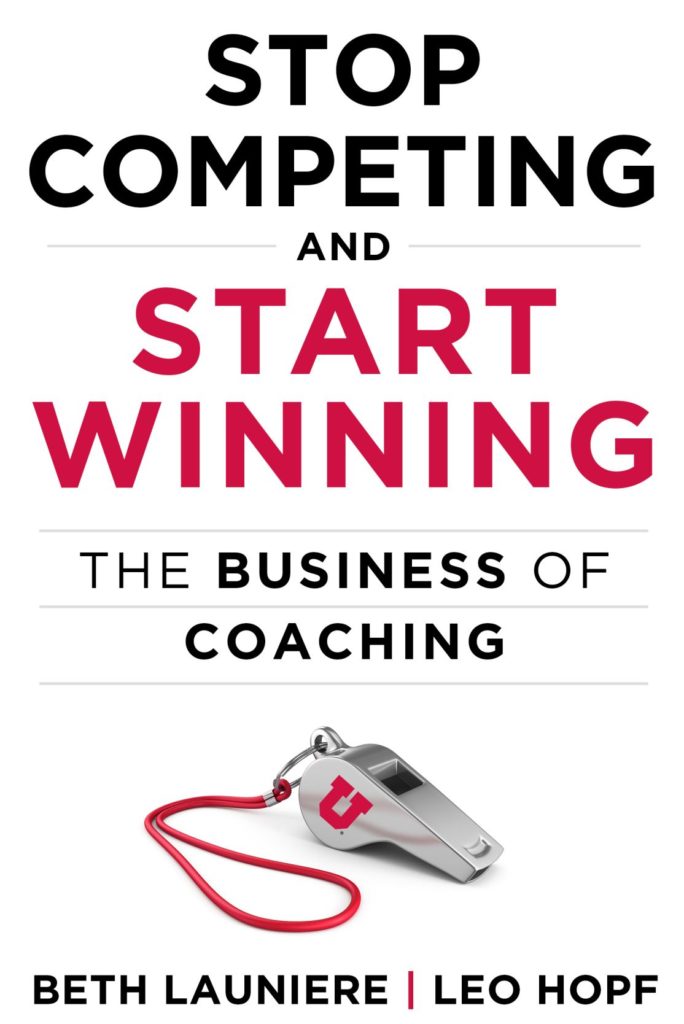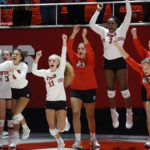“One hallmark of improvement devotees is this: they prospect for ideas where others have not. Beth and Leo struck pay dirt looking outside the world of sport—just the chapter on Delegation, and its Golden Rule, is worth a coach's time. Hungry for new coaching ideas? Your feast awaits.”
Karch Kiraly (coach of the USA women’s national volleyball team)
“Managing a staff is one of our great challenges as coaches. Everything starts at the top—how the staff works and relates will set the tone for the team. This book provides business concepts and tools to design any sports program or organization to win and reach the next level of success.”
Tara VanDerveer (two-time women’s basketball national champion at Stanford)
“Finally, a Management 101 guide specific to the coaching profession;
this book is invaluable for every coach.”
Kathy DeBoer (Executive Director, American Volleyball Coaches Association)
Previous slide
Next slide











This book will address questions such as:
- What does it take to design a program to win consistently, year after year?
- How can you set clear expectations so you realize full value from your star performers and deal appropriately with your “C” performers?
- How can you delegate effectively so the right work gets done by the right people in the right way?
- How should you manage and develop a staff that will deliver results and that will free up the head coach to do the things only they can do?
- How should you optimize staff interactions on both short-term tasks and longer-term projects?
- How can you assess your player’s capabilities, growth, and eventual ceilings so you can plan to fill gaps and leverage their particular strengths?
- How can you lead a program remotely during a crisis, such as the COVID-19 pandemic, and afterward, when things have evolved into a new normal?
- How can you look ahead and make sure your program is prepared for the future rather than being stuck in the past?
Beth Launiere and Leo Hopf have performed at the highest levels in their respective fields for more than 30 years. Beth has been the head volleyball coach at the University of Utah and is coming off of being named the Pac-12 Coach of the Year and reaching the NCAA Division One Sweet Sixteen. Leo is a management consultant who has advised the world’s most dynamic and complex organizations on their strategies, decision making, and organizational effectiveness.
Chapter 1: The Perfect Match
- Utah’s 2019 NCAA Draw
- Round One: Illinois
- Round Two: Preparing for BYU
- Round Two: Utah Defeats BYU in the Perfect Match
- Comments from Fans Who Attended the Perfect Match
- Preparing for Stanford in the Sweet Sixteen
- Round Three: The Sweet Sixteen vs. Stanford
- Reaction after the Loss to Stanford
- Comments from Other Coaches
- What Led to the Perfect Match?
Chapter 2: What It Means to be Designed to Win
- Characteristics of Programs That are Designed to Win
- Building a Program Designed to Win
- Management Demands Take Time Away from Coaching
- The Power of a Lasting Vision Statement
- The Hunger to Win
- Identifying and Overcoming Roadblocks
- Programs Designed to Win Still Have Low Points
- Red-Tailed Hawks vs. Field Mice
- The Importance of a Growth Mindset
- Having Ideas Others Don’t Gives You a Lasting Edge
- Measuring Success in a Program Designed to Win
Chapter 3: Stars and “C” Performers
- Characteristics of a Star
- Setting the Right Goals for Your Stars
- Developing Your Stars to Their Full Potential
- Your Stars Must Be Encouraged to Fail
- Case Study of the Power of Failure
- Case Study of a Star
- Why You Shouldn’t Treat Your Stars Like Family
- The True Cost of a “C” Performer is Far Higher Than You Think
- “C’s” Think They are Stars
- The Different Causes of “C” Performance
- It Takes a Lot of Work to Be a “C” Performer
- How You Might be Enabling “C” Performers
- Recognizing “C” Performers
- Thoughts on “C” Performers from a Fortune 100 CEO
- Dealing With “C” Performers
- Tool: The Left-Hand Column
- Dealing with Your “B’s”, the Solid Performers
- Your Solid Performers as the “Otherside”
Chapter 4: The Power of Delegation
- The Golden Rule of Delegation
- You Can’t Say “Yes!” until You Learn to Say “No.”
- People Judge Your Value Based on What They See You Do
- The Value You Add Depends on the Work You Choose to Do
- Tool: The Leadership Agenda
- Delegation Cascades Through Your Program
- Above-the-Line Example: Recruiting
- The Single Worst Approach to Delegation You Can Take
- What if There is No One to Whom You Can Delegate?
- Hiring Lower-Paid Workers is a Great Investment
- Truly Delegating vs. Kind-of Delegating
- You Can’t Delegate Responsibility
- Why is It Difficult to Truly Delegate?
Chapter 5: Creating Alignment by Using Givens
- Tool: Givens Clearly Define What is Being Delegated
- Examples of Givens in Volleyball
- Higher- and Lower-Level Givens
- Creating Clear and Effective Givens
- Phrase Givens Explicitly
- Start with Statements, End with Givens
- Tool: Quality Commitments
- Examples of Quality Commitments
- The Two Main Types of Work: Tasks and Projects
- The Danger of Confusing Tasks and Projects
- Tips for Leading Projects
- Game-Time Decisions
- Tool: Tell Less, Know More
Chapter 6: Developing Effective Staff Members
- Your Staffing Philosophy
- Aligning and Motivating Your Staff
- Give Your Staff Room to Breathe
- The Danger of Becoming Too Good at Only One Thing
- Tool: The DISC Behavioral Model
- Applying the DISC Behavioral Model
- Giving Effective Feedback
- Tool: Situation, Behavior, Impact (SBI)
- Helping Your People to Speak Up and Be Heard
- Building a Culture that Promotes Speaking Up
- Evaluating Your Staff
- Retaining and Motivating Your Staff
- Work/Life Balance During the Season
- Work/Life Balance During the Off-Season
- Showing Appreciation to Your Staff
Chapter 7: Hiring and Training Your Staff
- Professionalism Needs to be Taught
- If One Staff Member Knows, All Staff Members Know
- Staff Norms
- Assembling Your Staff
- Judging Talent
- Why Interviewing Candidates Tells You So Little about Them
- Tool: The Case Study Interview
- Choosing Topics for the Case Study Interview
- Avoiding Biases in Hiring and Recruiting
- The Value Case for Diversity
- Developing a Knowledge Storehouse
- Tool: The Searchable Online Knowledge Database
- Letting Staff Go
- Succession Planning
- Using Your Network to Help Your Staff Get Their Next Job
Chapter 8: Recruiting & Developing Your Players
- The Life of a Student-Athlete is a Unique Experience
- Filling Your Talent Pipeline
- Using Givens to Narrow Your Recruiting Pipeline
- The Critical Role of Walk-Ons
- The Underappreciated Value of Holding Back Scholarships
- When Players Leave Your Program
- Developing the Complete Player
- Defining Meaningful Roles for Every Player
- The Importance of Player Leadership
- Dealing with Disciplinary Issues
- Measuring Individuals’ Contribution to the Team
- Developing Annual Goals Aligned with the Program Vision
- The Contract with Parents
- Team Bonding
- Building Team Morale
- Not All Skills Contribute Equally to Winning
- Tool: The Utah RED Chart
- Plotting Your Utah RED Chart
- Developing Insights Using the Utah RED Chart
- Plotting Your Players on the Utah Red Chart
Chapter 9: Developing Fans and Donors
- Connecting with Fans
- Venues and Facilities
- The Block U Booster Club
- The Need for Donors
- The Donor Pyramid
- Issues with the Donor Pyramid
- The Utah Donor-Centric Model
- Involve Your Donors and Let Them Tailor Their Gifts
- Asking Donors for Money
- How to Get Your First Donor
- Donors Talk about Donors
- Advice from a Major Donor
- Planned Gifts
Chapter 10: Crisis Management and COVID-19
- Formal vs. Informal Interactions
- Crises are Over-Managed and Under-Led
- There Have Been Crises before COVID-19
- Communicating Progress During a Crisis
- Tool: Maslow’s Hierarchy of Needs
- Meeting Basic Physiological and Safety Needs
- Meeting Psychological Belongingness and Love Needs
- Meeting Psychological Esteem Needs
- Meeting Self-Actualization Needs
- Other Items for the University of Utah
- Other Items for Coaches
- Ramping Up Training
- How COVID-19 is Changing Athletics
- COVID-19’s Impact Now That the 2020 Season Has Been Delayed
Chapter 11: Preparing for the Future
- Tool: The Radar Screen
- Radar Screen Examples
- NCAA Sports Radar Screen: Outside Moving In
- NCAA Sports Radar Screen: Inside Moving Out
- Creating Your Radar Screen
- Examples of the Next Level of Detail on Your Blips
- Name, Image, and Likeness (NIL)
- Players Bringing Outside Leadership Concepts
- Increased Use of the Transfer Portal
- “Toughen Them Up” has Changed to Data-Driven Care
- Scheduling Based on Proximity vs. Scheduling to Maximize RPI
- Are You Prepared for the Future or Stuck in the Past?
- For Which Year are You Designed to Compete?
- How Fast are You Changing?
- Are You Designed to Win in the Coming Years?
Chapter 12: Leadership Ties Everything Together
- Coaching is Both an Art and a Science
- The Need for Both Leadership and Management
- Deep Understanding of the Business
- Deep Understanding of the Sport
- Vision as a Head Coach
- Using Vision in Recruiting Your Staff
- Vision as an Assistant Coach
- The Vision of a Big Hairy Audacious Goal (BHAG)
- Creating Your Vision Requires Big Blocks of Time
- Vision Requires Leadership Commitment
- The Importance of Inspired Leadership
- The Power of Empathetic Leadership
- Courage and Willingness to Take Risks
- Resiliency is Critical for Leadership
- Claiming Your Place at the Table
- Data-driven with an Ability to Connect the Dots
- Regression to the Mean
- Conviction Balanced with Judgment, Objectivity, and Humility
- Program Partners Bring Ideas from Outside of Your Sport
- Program Partner Relationships Must be Directed by the Coach
- Trust is Essential in Your Program Partners
- Results-driven and Measuring Progress Towards Winning
- Internal Leadership—Fighting Your Personal Dragon
- Leo’s Dragon: Nerves and Stage Fright
- Beth’s Dragon: Crohn’s Disease
- People Look to Leaders for Confidence
Chapter 13: Summary and How to Get Started
- The Differences Between Sports and Business
- Beth’s Reflections on the Book
- Leo’s Reflections on the Book
- The Main Points in Each Chapter
- How to Get Started